Related Research Articles
Romanitas is the collection of political and cultural concepts and practices by which the Romans defined themselves. It is a Latin word, first coined in the third century AD, meaning "Roman-ness" and has been used by modern historians as shorthand to refer to Roman identity and self-image.
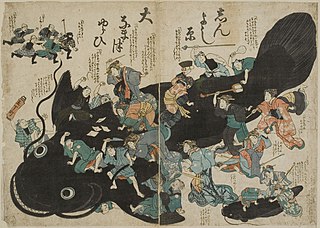
In Japanese mythology, the Namazu (鯰) or Ōnamazu (大鯰) is a giant underground catfish who causes earthquakes.
John Greville Agard Pocock is a historian of political thought from New Zealand. He is especially known for his studies of republicanism in the early modern period, his work on the history of English common law, his treatment of Edward Gibbon and other Enlightenment historians, and, in historical method, for his contributions to the history of political discourse.
Shō Shōken, also known as Haneji Wōji Chōshū, was a Ryukyuan scholar and served as sessei, a post often translated as "prime minister," from 1666 to 1673. Shō wrote the first history of the Ryukyu Kingdom, Chūzan Seikan, and enacted a number of practical political reforms aimed at improving Ryukyu's prosperity and dignity in the eyes of China and Japan.
Sessei (摂政) was the highest government post of the Ryūkyū Kingdom below the king; the sessei served the function of royal or national advisor. In the Ryukyuan language at the time, the pronunciation was closer to shisshii, and has only changed relatively recently. Though the same Chinese characters which compose the modern Okinawan word sessei are read as sesshō in Japanese, the position is not quite the same, and the Ryukyuan post is not derived from the Japanese model or system.
The Sanshikan (三司官), or Council of Three, was a government body of the Ryūkyū Kingdom, which originally developed out of a council of regents.
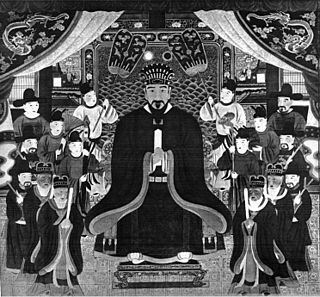
Shō Gen was king of the Ryukyu Kingdom from 1556 to 1572. He was called "Gen, the mute." The king required considerable support from the Sanshikan, the chief council of royal advisors. His reign marked the beginning of the Council's demonstration of significantly greater effectiveness and efficiency than previously.
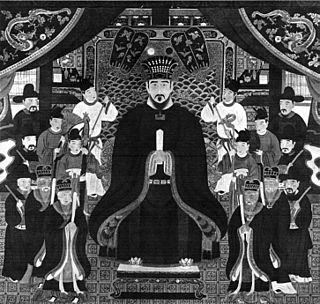
Shō Nei was king of the Ryukyu Kingdom from 1587–1620. He reigned during the 1609 invasion of Ryukyu and was the first king of Ryukyu to be a vassal to the Shimazu clan of Satsuma, a Japanese feudal domain.
Shō Sei was king of the Ryukyu Kingdom from 1526 to 1555. He was the fifth son of King Shō Shin, who he succeeded.
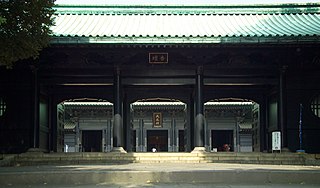
Hayashi Akira was an Edo period scholar-diplomat serving the Tokugawa shogunate in a variety of roles similar to those performed by serial Hayashi clan neo-Confucianists since the time of Tokugawa Ieyasu. He was the hereditary Daigaku-no-kami descendant of Hayashi Razan, the first head of the Tokugawa shogunate's neo-Confucian academy in Edo, the Shōhei-kō.
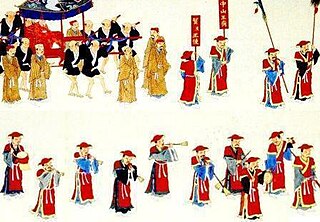
Over the course of Japan's Edo period, the Ryūkyū Kingdom sent eighteen missions to Edo, the capital of Tokugawa Japan. The unique pattern of these diplomatic exchanges evolved from models established by the Chinese, but without denoting any predetermined relationship to China or to the Chinese world order. The Kingdom became a vassal to the Japanese feudal domain (han) of Satsuma following Satsuma's 1609 invasion of Ryūkyū, and as such were expected to pay tribute to the shogunate; the missions also served as a great source of prestige for Satsuma, the only han to claim any foreign polity, let alone a kingdom, as its vassal.
Tsūkō ichiran (通航一覧) is a mid-19th century Japanese compilation of documents or "survey of intercourse" related to the foreign relations of the Tokugawas and the Tokugawa shogunate.
Shō Shitsu was a king of the Ryukyu Kingdom who held the throne from 1648 until his death in 1668.

Shō Hō was a king of the Ryukyu Kingdom. He succeeded Shō Nei, whose reign saw the invasion of Ryukyu by Japanese forces in 1609 and the subjugation of the kingdom to Satsuma Domain, and ruled from 1621 until 1640.

Shō Tei was the 11th King of the Second Shō Dynasty of the Ryukyu Kingdom, who held the throne from 1669 until his death in 1709. He was the ruler of Ryukyu at the time of the compiling of the Chūzan Seifu.

Turtleback or Turtle-back tombs or turtle shell tombs are a particular type of tombs commonly found in some coastal areas of Fujian, China, the Ryukyu Islands of Japan and in Quang Nam province of Vietnam.

The Ryukyu Domain was a short-lived domain of the Empire of Japan, lasting from 1872 to 1879, before becoming the current Okinawa Prefecture and other islands at the Pacific edge of the East China Sea.
Shō Toku was the son of Shō Taikyū and last king of the First Shō Dynasty. He came to power as a young man in a kingdom whose treasury had been depleted. He engaged in efforts to conquer islands between Ryukyu and Japan and took the Mitsudomoe, the symbol of Hachiman, as his banner to emphasize his martial spirit. In 1466, he led an invasion on Kikai Island, which strained the Ryukyuan treasury with little benefit. He either died young or was possibly killed by forces within the kingdom as details are somewhat unclear. As is common for rulers who preside over the end of a dynasty, moralists portrayed him as cruel, violent, and lacking in virtue.
Onarigami is the ancient belief of the Ryūkyūan people that spiritual power is the domain of women. The roles of women in Okinawan society and the ritual traditions of the Ryūkyūan religion are related to this belief. Women with exceptionally high spiritual power are called kaminchu (神人) and many have specific jobs in society. Though the role of priestesses has changed over time, they are still celebrated in Okinawa today.

Zenon Eugene Kohut is a Canadian historian specializing in Early Modern Ukrainian History. He retired as professor emeritus, University of Alberta. From 1992 to 2014 Kohut worked at the University of Alberta's Canadian Institute of Ukrainian Studies (CIUS) where he served as the first head of the Stasiuk Program for the Study of Contemporary Ukraine and acted as editor of the Journal of Ukrainian Studies (1990–92). He was acting director (1993) and director (1994–2012) of the Program.
References
- 1 2 Pennsylvania State University, "Gregory James Smits"; retrieved 2013-3-22.
- ↑ WorldCat Identities Archived 2010-12-30 at the Wayback Machine : Smits, Gregory 1960-